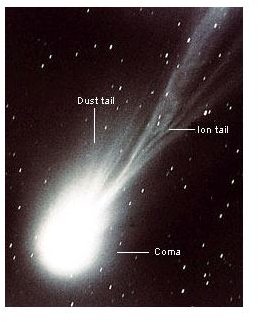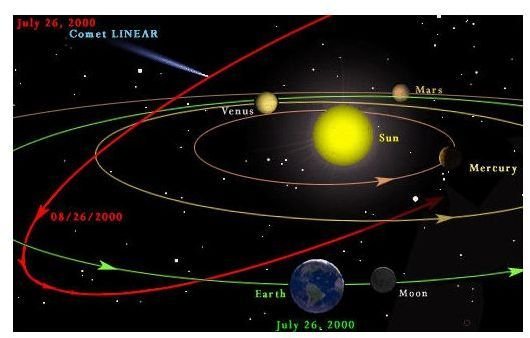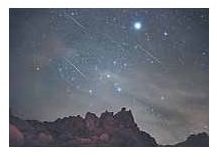Meteor Shower Facts and What Causes Them
Meteor Showers
Meteor showers are the results of our fellow celestial bodies orbiting our sun, comets. A comet is usually made of a ball of dust and ice. When a comet passes the sun it will heat up and leave particles of dust and ice in it’s wake (the tail). These comet tails are what give us our Earthly meteor showers. As the Earth orbits the sun and passes through the dust cloud or tail from a comet, it is bombarded all at once by particles as small as sand grains or sometimes (but rarely) as large as boulders. The fireballs in the sky we observe are caused by ram pressure of these particles hitting Earth’s atmosphere. Here are some facts of meteor showers:
Facts
•

Why do they light up? Ram Pressure is not the same as friction. Ram pressure is caused by the extreme rapid compression of air in front of the meteoroid leaving the vacuum of space. The rapid compression vaporizes the smaller particles which produces the light we observe.
• Why do they have different colors? Meteor showers can produce different colors of light. The difference in the color of light is caused by the different chemical make ups of meteors being vaporized. Sodium particles can produce orange/yellow light, iron will produce yellow, magnesium creates bluish/green, calcium makes violet and silicate meteors produce fiery red colors.
• What colors can they be? Velocity of the falling meteorites can also determine the color. Slow meteors can be red or orange, while fast meteors frequently have a blue color.
• How fast are they? Meteor speeds can vary. They can travel as slow as 25,000 mph and reach speeds up to 160,000 miles per hour.
•

Where do they go? Meteors are traveling in the same trajectory or path of the comet that produced them
• What are meteorites? Larger particles that do survive the effects of ram pressure can hit Earth, these are called meteorites.
• What are meteoroids? Pieces of debris from comets are called meteoroids.
• What is a meteor storm? When we pass through a particularly dense cloud of meteoriods is when we get a meteor shower or if it is very dense it can be called a “meteor storm”
• How do we know when the shower is? Meteor showers are predicted by calculating when Earth’s orbit will pass through the clouds of meteoroids left in the passing comets orbit
• Do they hit the earth? Most meteors completely burn up in the atmosphere at altitudes between 60 and 80 miles.
• What is the radiant point? A radiant point is caused by the perspective of the observer. A radiant point is similar to railroad tracks converging at a single vanishing point on the horizon when viewed from the middle of the tracks by the observer.
• How are they named? Meteor showers can have names like the Leonids or the Geminids. The name derives from the meteor shower appearing to radiate from the constellation Leo, or Gemini.
• How to view a meteor shower: Best conditions to view a meteor shower is on a dark moonless night. Drive out of the city towards the constellation the meteor shower is radiating from. Less light pollution will give the observer a better view of the shower. Special note: if you drive the wrong direction (i.e. north instead of south) you will be trying to view the event through the light pollution you are also trying to escape. No special equipment needed. You can watch a meteor shower with the naked eye.
• Major meteor showers predicted for the lower 48 states every year:
- Quadrantids January 3
- Lyrids: April 21/22
- Eta Aquarids: May 5
- Perseids: August 12
- Orionids: October 21
- Leonids: November 17/18
- Geminids: December 13/14
Amazing Facts

1. The Leonid meteor storm of 1833 must have been a spectacular show of fireworks. Meteor showers were previously thought of as an atmospheric phenomena. The shower of 1833 spurred more intense scientific investigation of how meteor showers originated. Estimates of meteors falling per hour in this storm range from 100,000 meteors per hour up to an excess of 200,000 meteors per hour. This shower was seen in the entire region of North America, east of the Rocky Mountains. Many Americans took this as a sign of the end of the world.
2. The largest meteorite found on Earth is known as the Hoba Meteorite. Accidently found by a farmer plowing his fields in the country of Namibia, this meteor weighs approximately 60 tons. This meteorite is made up of about 82.4% iron, 16.4% copper, and 0.76% cobalt. The meteorite is estimated to have fallen 80,000 years ago and the age is estimated to be between 200-400 million years old.
3. You can hear a meteor shower on your radio. Set your FM radio to a familiar station that is too far away to hear normally. The ionized trail of the meteor will reflect the radio signal and you can hear clips of your radio station. Each clip or snip you hear is a meteor falling into our atmosphere.
Image Credits
https://www.nasa.gov/worldbook/comet_worldbook.html
https://en.wikipedia.org/wiki/Leonid_meteor_shower
https://www.nasa.gov/audience/forstudents/5-8/features/F_Leonid_Meteor_Shower.html
https://cse.ssl.berkeley.edu/SegwayEd/lessons/cometstale/com3_b.html
